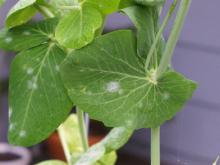Cause Erysiphe pisi (= Alphitomorpha pisi = Ischnochaeta pisi; anamorph Oidium arachidis), a fungus that can be seedborne but usually survives as conidia on living plants. Normally the disease does not cause serious losses if peas are planted in spring or an early-maturing variety is planted. When peas are recropped on the same ground, the fall planting sometimes develops problems.
Symptoms The first symptom is powdery white mycelium and spores on leaf and stem surfaces. On some varieties, affected areas may die. All varieties are dwarfed if infested early. Affected pods of some varieties, including Oregon Sugar Pod, develop small brown to black necrotic spots.
Cultural control
- Plant early-maturing varieties.
- Many resistant varieties are available.
- Plant early in the growing season.
- Rotate plantings at least 1 year.
Chemical control
- Affiance (Group 3 + 11) at 10 to 19 fl oz/A on 14- to 21-day intervals. Preharvest interval is 14 days. 12-hr reentry.
- Aprovia Top (Group 7 + 3) at 10.5 to 11 fl oz/A on 7- to 14-day intervals for dried shelled pea only. Do not apply more than two (2) sequential applications or two (2) application per year. Preharvest interval is 14 days. 12-hr reentry.
- Bicarbonates are registered to control powdery mildew. Thorough coverage is essential.
- Bi-Carb at 4 teaspoons/2 gal water on 7- to 10-day intervals. May be applied up to the day before harvest. H O.
- Carb-O-Nator at 2.5 to 5 lb/100 gal of water on 5- to 14-day intervals, depending on disease pressure. Preharvest interval is zero (0) days for all listed crops. 4-hr reentry. O
- Kaligreen at 2.5 to 3 lb/A on 7- to 10-day intervals. May be applied up to the day before harvest. 4-hr reentry. O
- MilStop at 2 to 5 lb/A on 7- to 14-day intervals. May be applied on the day of harvest. 1-hr reentry. O
- Vacres at 2.5 to 5 lb/A on 7- to 14-day intervals. Preharvest interval is zero (0) days. 4-hr reentry.
- Copper products (Group M1) are not effective as stand-alone materials. Care must be taken to avoid build-up in the soil.
- Badge SC at 0.5 to 2.5 pints/A on 7-day intervals. Preharvest interval is 0 days. 24-hr reentry for greenhouse use; 48-hr reentry for all other applications.
- Bonide Liquid Copper is available for home gardens. H
- Champ WG at 1.58 lb/A on 7-day intervals. 48-hr reentry. O
- Cueva at 0.5 to 2 gal/100 gal water on 7- to 10-day intervals. May be applied on the day of harvest. 4-hr reentry. O
- Cuprofix Ultra 40 Disperss at 1 to 2 lb/A on 7- day intervals. 48-hr reentry.
- Kocide 2000 at 1 to 2.25 lb/A or Kocide 3000 at 0.5 to 1.25 lb/A on 7-day intervals. 48-hr reentry.
- Nu-Cop 50 WP at 1.5 lb/A on weekly intervals. 48-hr reentry. O
- Previsto at 0.75 to 2 quarts/A on 7- day intervals. 48-hr reentry. O
- Endura (Group 7) at 8 to 11 oz/A on 5- to 14-day intervals. Do not feed treated pea commodities to livestock. Preharvest interval is 21 days for dried peas and 7 days for succulent peas. 12-hr reentry.
- Heads Up at 0.035 oz/34 fl oz water/360 lb seed will stimulates pest suppression system of plants. 12-hr reentry. O
- OSO 5% SC (Group 19) at 3.75 to 13 fl oz/A on 7- to 14-day intervals. Can be applied the day of harvest. 4-hr reentry O.
- Regalia (Group P5) at 1 to 4 quarts/A plus another fungicide on 7- to 10-day intervals. Does not benefit from the addition of an adjuvant. Preharvest interval is 0 days. 4-hr reentry. O
- Sulfur formulations are registered. Sulfur is fungitoxic in its vapor phase and, therefore, is effective only when air temperatures promote volatilization. Sulfur volatilizes above 65°F but becomes phytotoxic above 95°F. Using it above 85°F is not recommended. Although sulfur reduces sporulation of established infections, it is primarily a protectant and must be applied before infection. Begin applying when weather conditions are appropriate and continue at weekly intervals.
- Bonide Sulfur Plant Fungicide RTU is available for home gardens. H O
- Microthiol Disperss at 7 lb/A on 14-day intervals. 24-hr reentry. O
- Sulfur 6L (52% sulfur) at 3 to 7 pints/A. 24-hr reentry.
- Trilogy at 0.5% to 1%. Not labeled for use in Oregon. Do not use above 90°F or when plants are under heat or moisture stress. Do not use when foliage is wet as good coverage is essential. Poor control as a stand-alone product. 4-hr reentry. O
Biological control Efficacy unknown in the Pacific Northwest.
- Double Nickel LC at 1 to 6 quarts/A on 3- to 10-day intervals. Can be applied the day of harvest. 4-hr reentry. O
- Ecoswing at 1.5 to 2 pints/A. Preharvest interval is 0 days. 4-hr reentry. O
- Romeo at 0.23 to 0.68 lb/A on 7- to 10-day intervals starting prior to infection. Preharvest interval is 0 days. 4-hr reentry. O
- Sonata at 2 to 4 quarts/A on 7- to 14-day intervals. Can be applied up to and on the day of harvest. 4-hr reentry. O


